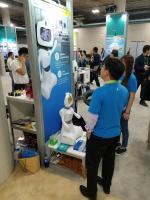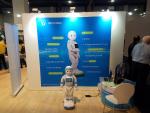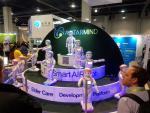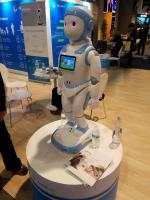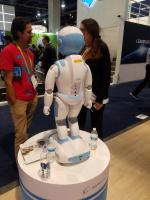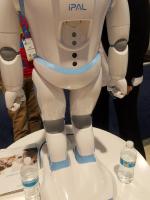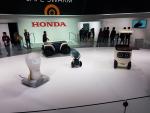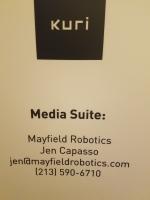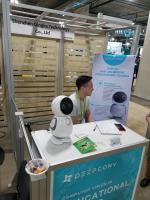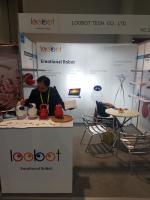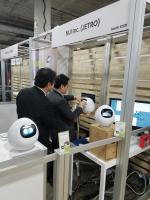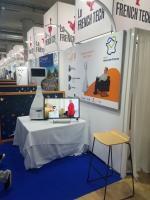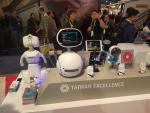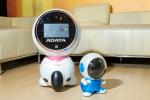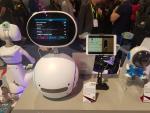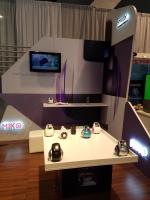The section covers social and companion robots. Compared to personal or service robots, the key selling point of these products is the ability to communicate using natural language or emotional expression.
Robelf
This robot is basically a computer on a 3-wheel base, although it does have a pair of 1-DOF arms that could be used to make gestures.
It wasn’t doing much at CES so it’s not clear how well it drives on carpet.
Their website describes it as a social robot, teacher and security monitor.
Website: www.robelf.com
iPal by AvatarMind
The iPal is a humanoid robot designed for educational, companionship or hospitality applications.
Website www.ipalrobot.com
3E-A18 by Honda
The 3E-A18 is designed to be a “companion robot”.
It has an interesting mechanical design. It appears to have a spherical drive and moves smoothly across the floor. I only saw the robot spin in place, not move sideways, so it may just use wheels. However, if you look closely when the robot is stopped, you can see a small oscillation in the base. This suggests the robot is balancing or has a suspension system. There is a sleek-looking castor wheel at the back, for stability.
The robot also has a soft skin surface and the face graphics appear to be projected onto the inside surface of the skin.
However, more work on the sensors and software is required for it to actually interpret or display emotion.
They were also showing their 3E-B18 personal mobility device,
the 3E-C18 “handyman robot”, which is like a multipurpose, self-driving utility cart,
and 3E-D18, a 4-wheeled “work horse” that looks like an electric ATV without the handlebars/seat.
Website: world.honda.com/CES/2018/
Kuri by Mayfield Robotics
Unfortunately they had no booth, just a media suite.
Apparently they were giving away plush robot toys like that in Fig. 10.
Website: www.mayfieldrobotics.com
|
Fig. 10:
|
Hugo by Moorebot / Shenzhen Pilot Labs Technologies Co. Ltd
A desktop assistant that they describe as “Amazon Alexa with a big eye”.
Website: www.moorebot.com/en/
DeepConv / Shenzhen Qingka Technology Co. Ltd
They had a robot that can apparently help children improve their reading. It looks to be just a computer built into a static robot body.
Their website says they also develop computer vision software for human pose estimation or activity recognition.
Website: www.deepconv.ai
Loobot Tech. Co. Ltd
Loobot is a small desktop robot designed for entertainment and making video calls.
Not to be confused with “LooBot”, a smartphone app for finding nearby toilets.
Website: www.loobot.net/en/
Haapie-One by Haapie
A small, desktop robot. It basically looks like a smartphone in a cute body, which is the case for many social robots.
Website: www.haapie.com/en/
Tapia by MJI Inc. (Jetro)
This is another smartphone in a cute body. It’s advertised as a companion or elder care robot.
Website: www.mjirobotics.co.jp/en/
Cutii (formerly Yumii)
I didn’t see this working, but it’s an elder-care or companion robot.
Website: www.cutii.io/en/
Arobot by Adata
This tiny robot called “Arobot” is designed for education, remote monitoring of your child, or elder care (Fig. 17).
Adata also has a larger robot called “ibotn”, which looks like a smartphone based robot, also with remote monitoring.
Here’s a news article from Business Next that describes why A-Data has diversified from memory chips into home robots:
www.bnext.com.tw/adata-released-two-home-robots (in Chinese) (English translation)
|
Fig. 17: |
Fig. 18: ibotn and Arobot. |
Zenbo by ASUS (ASUSTeK Computer Inc.)
Zenbo is designed to be a companion, your personal assistant, or for entertainment.
It has a tablet for a face, Intel Atom processor, and both 2D and 3D cameras.
It moves about on a differential drive base, with two castor wheels for stability.
Website: zenbo.asus.com
The diff-drive base could be a nice platform for hackers to modify.
If you want to see what’s inside the robot, checkout this website:
www.liliputing.com/asus-zenbo-robot-complete-teardown
or see the official documents from the FCC:
www.fccid.io/MSQ-ZENBO
Miko by Emotix
Miko is advertised as “India’s first companion robot” for children.
Website: www.emotix.in
